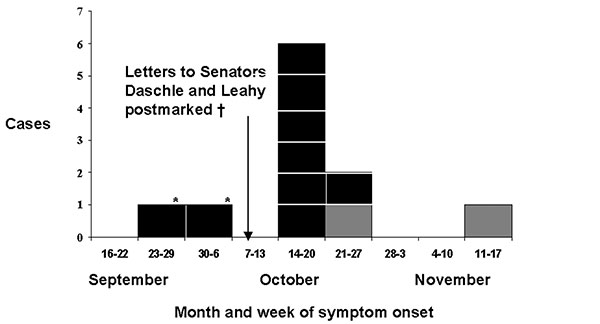Volume 9, Number 6—June 2003
Research
Bioterrorism-related Inhalational Anthrax in an Elderly Woman, Connecticut, 2001
Figure 1

Figure 1. Bioterrorism-related inhalational anthrax cases by week of symptom onset—United States, 2001.The first two cases of inhalational anthrax occurred in Florida. Though no direct exposure source was found, environmental samples of the media company in which these two patients worked and the postal facilities serving the media company yielded Bacillus anthracis spores specifically implicating a B. anthracis–containing letter or package (4): †, the letters to Senators Thomas Daschle and Patraick Leahy were postmarked in the Trenton, New Jersey, processing and distribution center on October 9, 2001; black bars indicate cases of inhalational anthrax in persons with direct exposure to a B. anthracis–containing letter; gray bars indicate cases of inhalational anthrax persons with no known B. anthracis exposure.
References
- Centers for Disease Control and Prevention. Update: investigation of bioterrorism-related anthrax and interim guidelines for clinical evaluation of persons with possible anthrax. MMWR Morb Mortal Wkly Rep. 2001;50:941–8.PubMedGoogle Scholar
- Centers for Disease Control and Prevention. Update: investigation of bioterrorism-related inhalational anthrax—Connecticut, 2001. MMWR Morb Mortal Wkly Rep. 2001;50:1049–51.PubMedGoogle Scholar
- Barakat LA, Quentzel HL, Jernigan JA, Kirschke DL, Griffith K, Spear SM, Fatal inhalational anthrax in a 94-year-old Connecticut woman. JAMA. 2002;287:863–8. DOIPubMedGoogle Scholar
- Jernigan J, Stephens D, Ashford D, Omenaca C, Topiel MS, Galbraith M, Bioterrorism-related inhalational anthrax: the first 10 cases reported in the United States. Emerg Infect Dis. 2001;7:933–44. DOIPubMedGoogle Scholar
- Centers for Disease Control and Prevention. Update: investigation of bioterrorism-related anthrax and interim guidelines for exposure management and antimicrobial therapy, October 2001. MMWR Morb Mortal Wkly Rep. 2001;50:909–19.PubMedGoogle Scholar
- Centers for Disease Control and Prevention. Epidemiologic notes and reports: anthrax—Connecticut. MMWR Morb Mortal Wkly Rep. 1968;17:102.
- Keim P, Price L, Klevytska A, Smith KL, Schupp JM, Okinaka R, Multiple-locus variable-number tandem repeat analysis reveals genetic relationships with Bacillus anthracis. J Bacteriol. 2000;182:2928–36. DOIPubMedGoogle Scholar
- Hoffmaster AR, Fitzgerald CC, Ribot E, Mayer LW, Popovic T. Molecular subtyping of Bacillus anthracis and the 2001 bioterrorism-associated anthrax outbreak, United States. Emerg Infect Dis. 2002;8:1111–6.PubMedGoogle Scholar
- Centers for Disease Control and Prevention. Update: investigation of bioterrorism-related anthrax—Connecticut, 2001. MMWR Morb Mortal Wkly Rep. 2001;50:1077–9.PubMedGoogle Scholar
- Williams AA, Parashar UD, Stoica A, Ridzon R, Kirschke DL, Meyer RF, Bioterrorism-related anthrax surveillance, Connecticut, September–December, 2001. Emerg Infect Dis. 2002;8:1078–82.PubMedGoogle Scholar
- Centers for Disease Control and Prevention. Comprehensive procedures for collecting environmental samples for culturing Bacillus anthracis (revised April 2002). Accessed March 2003. Available from URL: http://www.bt.cdc.gov/agent/anthrax/environmental-sampling-apr2002.asp
- Teshale EH, Painter J, Burr GA, Mead P, Wright SV, Cseh LF, Environmental sampling for spores of Bacillus anthracis. Emerg Infect Dis. 2002;8:1083–7.PubMedGoogle Scholar
- Centers for Disease Control and Prevention. Evaluation of Bacillus anthracis contamination inside the Brentwood mail processing and distribution center—District of Columbia, October 2001. MMWR Morb Mortal Wkly Rep. 2001;50:1129–33.
- Centers for Disease Control and Prevention, American Society of Microbiology, Association of Public Health Laboratories. Basic diagnostic testing protocols for level A laboratories for the presumptive identification of Bacillus anthracis. Accessed March 2003. Available from URL: http://www.bt.cdc.gov/agent/anthrax/LevelAProtocol/ban-la-cp-031802.pdf
- Jernigan DB, Raghunathan PL, Bell BP, Brechner R, Bresnitz EA, Butler JC, Investigation of bioterrorism-related anthrax, United States, 2001: epidemiologic findings. Emerg Infect Dis. 2002;8:1019–28.PubMedGoogle Scholar
- Traeger MS, Wiersma ST, Rosenstein NE, Malecki JM, Shepard CW, Raghunathan PL, First case of bioterrorism-related inhalational anthrax in the United States, Palm Beach, Florida, 2001. Emerg Infect Dis. 2002;8:1029–34.PubMedGoogle Scholar
- Hsu VP, Lukacs SL, Handzel T, Hayslett J, Harper S, Hales T, Opening a Bacillus anthracis–containing envelope, Capitol Hill, Washington, D.C.: the public health response. Emerg Infect Dis. 2002;8:1039–44.PubMedGoogle Scholar
- Ingelsby TV, O’Toole T, Henderson DA, Bartlett JG, Ascher MS, Eitzen E, Anthrax as a biological weapon, 2002: updated recommendations for management. JAMA. 2002;287:2236–52. DOIPubMedGoogle Scholar
- Gleiser CA, Berdjis CC, Hartman HA, Gochenour WS. Pathology of experimental respiratory anthrax in Macaca mulatta. Br J Exp Pathol. 1963;44:416–26.PubMedGoogle Scholar
- Webb GF, Blaser MJ. Mailborne transmission of anthrax: modeling and implications. Proc Natl Acad Sci U S A. 2002;99:7027–32. DOIPubMedGoogle Scholar
- Holtz TH, Ackelsburg JA, Kool J, Rosselli R, Marfin A, Matte T, Isolated case of inhalational anthrax due to intentional contamination, New York City, 2001. Emerg Infect Dis. 2003; 9.